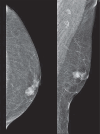Diseases of the Male Breast: Gynecomastia and Breast Cancer
- PMID: 40331995
- PMCID: PMC12580830
- DOI: 10.3238/arztebl.m2025.0071
Diseases of the Male Breast: Gynecomastia and Breast Cancer
Abstract
Background: Gynecomastia (GM) is the most common abnormality of the male breast; it is benign and usually bilateral. GM is a manifestation of disease and not a diagnosis in itself. An important differential diagnosis of unilateral GM is breast cancer.
Methods: This narrative review is based on pertinent publications from 2010 onward that were retrieved by a PubMed search, with special attention to the guidelines of the AWMF and the European Academy of Andrology (EAA) and the recommendations of the German Society for Gynecology and Obstetrics.
Results: GM can occur physiologically in newborns, during puberty, and in men over age 65. The basic diagnostic evaluation of GM consists of a thorough history and physical examination (especially of the breast area and genitals), breast and testicular sonography, and laboratory testing for total testosterone (tT), estradiol (E2), luteinizing hormone (LH), human chorionic gonadotropin (hCG), and prolactin (PRL) levels. Further tests to be carried out as indicated according to the clinical findings include the determination of follicle-stimulating hormone (FSH), thyroid-stimulating hormone (TSH), fT4, alpha-1-fetoprotein (AFP), dehydroepiandrosterone (DHEA), and free testosterone (fT) levels, liver and kidney function tests, chromosomal analysis, and supplementary imaging procedures. The treatment depends on the underlying disease and the severity of symptoms, ranging from further observation alone to pharmacotherapy and surgery. Approximately 700 men receive a diagnosis of breast cancer each year in Germany. Because breast cancer in men is rare, there are no pertinent studies, and its treatment is analogous to the treatment of breast cancer in women as recommended in the guidelines.
Conclusion: Men should be included in clinical trials of treatment for breast cancer whenever this is fea - sible, so that the evidence base can be enlarged and men can be given access to innovative treatment methods.
Figures
References
-
- Kanakis GA, Nordkap L, Bang AK, et al. EAA clinical practice guidelines-gynecomastia evaluation and management. Andrology. 2019;7:778–793. - PubMed
-
- Schanz S, Schreiber G, Zitzmann M, et al. S1-Leitlinie: GM im Erwachsenenalter. AWMF Registernummer 013-039. J Dtsch Dermatol Ges. 2017;15:465–472. - PubMed
-
- Swerdloff RS, Ng JCM. Gynecomastia: Etiology, diagnosis, and treatment. In: Feingold KR, Anawalt B, Blackman MR, et al., editors. Endotext [Internet] South Dartmouth (MA): MDText.com; 2023.
-
- Braunstein GD. Clinical practice. Gynecomastia. N Engl J Med. 2007;357:1229–1237. - PubMed
Publication types
MeSH terms
LinkOut - more resources
Full Text Sources
Medical


